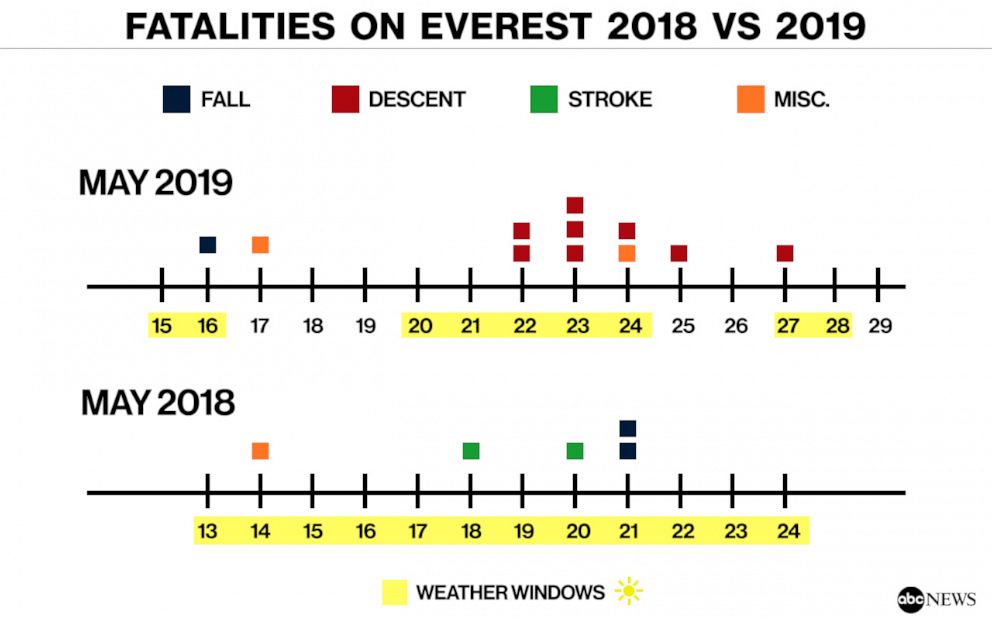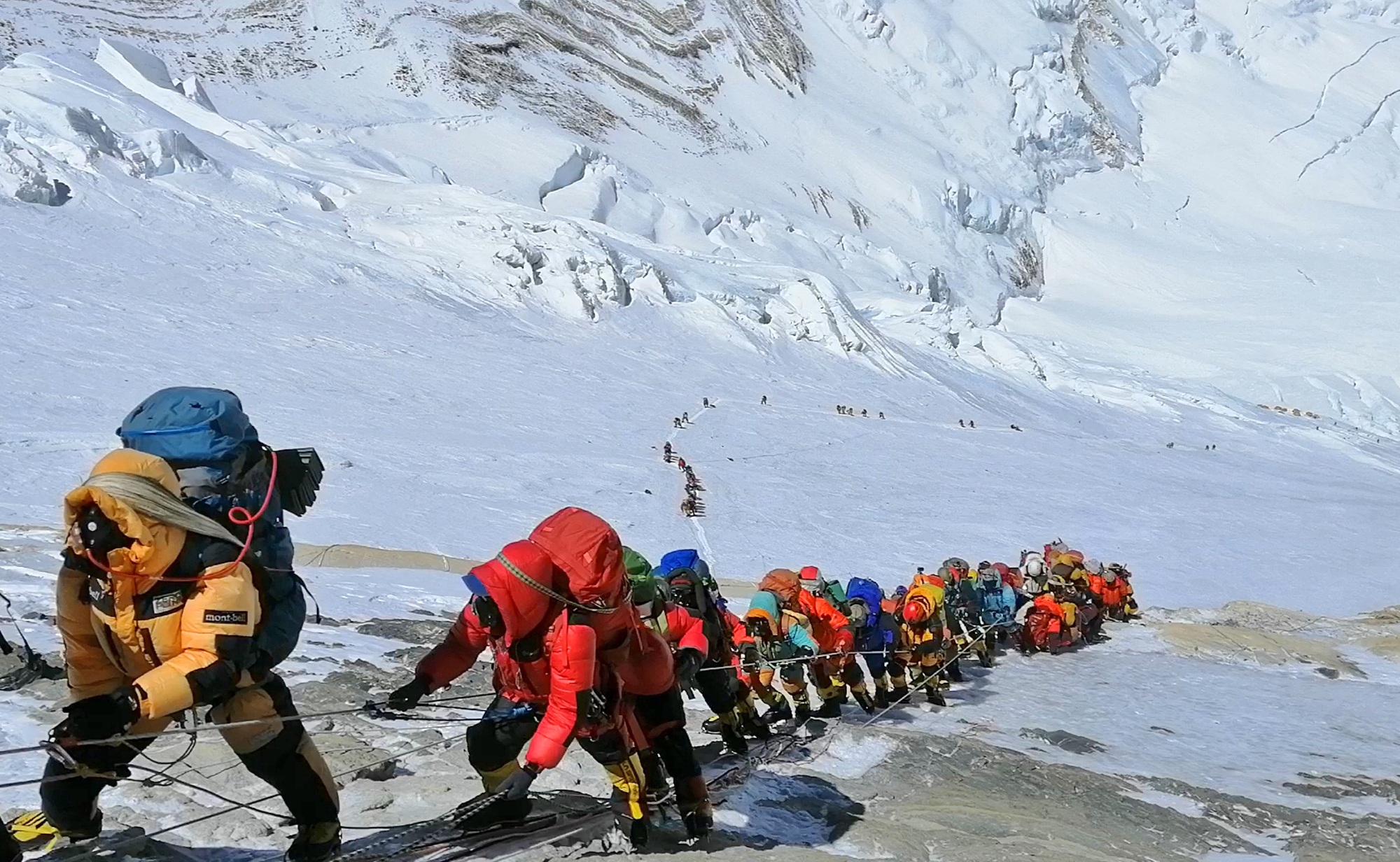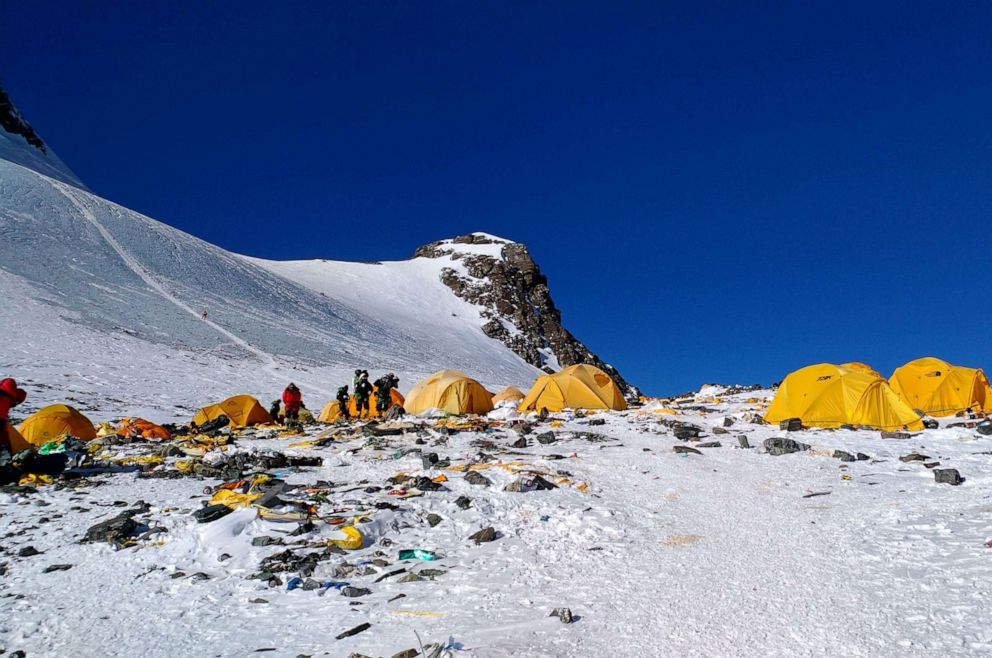How one of the deadliest seasons on Mount Everest unfolded, leading to 11 deaths
A difference in weather windows created a difference in deaths.
The 2019 season on Mount Everest is coming to a close and going down as one of the deadliest seasons on record.
Eleven people died on the world's tallest mountain this year, most within the past week or so, as images of lines of people bottlenecked near the summit circulated on social media.
People die every year on Everest from falls, storms, avalanches, lack of oxygen, freezing or underlying health issues. But this year stood out because so many of the deaths happened while a climber was on the descent from the summit on clear weather days.
"The major contributing factor this year was the narrow weather window we had," Krishma Poudel, manager of Peak Promotion, one of the companies that lost a climber this year, told ABC News.
Mid to late May is the ideal time to climb Everest, when a jet stream that sits over the mountain -- blasting winds up to 200 mph at the summit -- subsides for short periods of time, creating "weather windows" that make it safe to stand on the peak. It's during those weather window days that climbers leave camps to make attempts at the summit.
"Because of global warming, the weather window is sometimes smaller, sometimes bigger," Poudel said.
Last year was unique in that a weather window lasted for 11 days straight from May 13 through 24, according to expert Alan Arnette and meteorologist Chris Tomer, allowing climbers lots of time to make their attempts -- and, importantly, allowing for groups to spread out when they made summit attempts.
This year, however, weather windows came and went quickly, with the main one lasting just a few clear days.

That was when most of the deaths occurred this season. Single-file lines of people piled up around the summit, creating hours of delays, including on the descent. The longer a person stays at that height, the higher their chance is of succumbing to high altitude sickness and exhaustion.
This season's narrow weather windows -- paired with a record high number of permits for climbers issued by Nepal as well as inexperience in climbers and staff -- created catastrophes. This is how it played out.
May 14-16: First weather window
Everest seasons begin with teams of guides and Sherpas setting lines of ropes up the mountain. That job was finished this year with a weather window on May 14.
The first summits began shortly after that, per Arnette's records, and continued in a weather window through May 16.
This period also saw the start of tragedy on the mountain as people started attempts. Irishman Seamus Lawless reached the peak on May 16, but experienced a fall on the descent, the BBC reported. He is presumed dead.
May 17-19: Waiting
And then, the weather window was gone. Climbers were left sitting at camps waiting for the weather to clear up again.
However, the first weather window still had an impact. Climber Ravi Thakar of India, who was in the same expedition as Lawless, according to The Himalayan Times, was found dead in his tent at Camp IV -- just below the 8,000-meter "death zone" -- after descending from the summit.
May 20-21: Weather window starts opening up
Finally, another weather window was forecasted to open up, but it was a short one. This window started slowly and coldly as the jet stream was still coming away from the mountain, with just a handful of summits on May 20.
May 22-24: Major weather window; rush to the top
But between May 22 and May 24, an estimated hundreds of climbers and service staff pushed their way to the top, creating the now-viral lines near the summit. Official numbers are not yet available.

With this rush to the top came a series of deaths.
On May 22, American Donald Lynn Cash and Anjali Kulkarni of India died while descending from the peak. Pioneer Adventure, the company Cash climber with, wrote that he fainted due to high altitude sickness. Arun Treks, the company Kulkarni climbed with, said the heavy traffic caused her death as she had to wait to descend, per the South China Morning Post.
May 23 saw three more deaths during descents: Indian climbers Nihal Bagwan and Kalpana Dash and Ernst Landgraf of Austria.
Two peopled died May 24, including Irish climber Kevin Hynes, who died during the descent, per the BBC. Dhruba Bista, a Nepali climbing guide, died at base camp after being transported there from higher on the mountain, where he fell ill, according to CNN.
May 25-26: Season winds down
As the end of May is the end of the Everest climbing season and the weather window closed, climbers filed out, away from the mountain.
But it wasn't yet the end of tragedy on the mountain. British climber Robin Hayes Fisher died shortly after summiting on May 25.
May 27-29: One more weather window, but climbers emptied out
One last gush of a weather window breezed through this week, after most climbers had already come and gobe.
It was in this last push that the latest -- and possibly last of the season -- death occurred. American Chris Kulish died during his descent on May 27.
2019 vs. 2018

The 2019 season stands in sharp contrast to 2018, and there's a clear correlation between the number and types of deaths compared to the weather windows.
As 2018 saw an 11-day weather window, climbers spread out their attempts. There were five deaths on the mountain in 2018 -- and none occurred in the way 2019's deaths did during descents shortly after reaching the peak.
One sherpa, Lam Babu Sherpa, went missing during a descent in bad weather, according to Outside magazine, and was presumed dead on May 14.
Another sherpa, Pasang Norbu Sherpa, died May 18 during an ascent to the summit from a stroke, per The Himalayan Times.
Macedonian climber Gjeorgi Petkov died May 20 of a presumed stroke, according to the Associated Press.
Finally, in two separate incidents on May 21, Damai Sarki Sherpa of Nepal and Nobukazu Kuriki of Japan died after falls.
"You spend a lot of money, energy and ambition to attempt Everest, and everybody wants to attempt it once they're there at the base camp," Poudel said. "The weather window pushed everybody to do it in a very short time."




